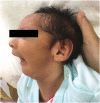Case Report: Multiorgan Involvement with Congenital Zika Syndrome
- PMID: 32723426
- PMCID: PMC7543855
- DOI: 10.4269/ajtmh.20-0421
Case Report: Multiorgan Involvement with Congenital Zika Syndrome
Abstract
We report the case of an infant born with congenital Zika syndrome (CZS). During the largest Zika virus (ZIKV) outbreak in Peru, the mother presented with fever and rash that were confirmed to be due to ZIKV by real-time PCR. The infant was born with severe microcephaly. Imaging revealed corpus callosum dysgenesis, lissencephaly, ventriculomegaly, and calcifications. Mild hypertrophic cardiomyopathy with diastolic dysfunction was reported in the echocardiogram. Valgus deviation of the lower extremities and a left clubfoot were diagnosed at birth. The hip ultrasound showed incipient signs of Graf type II dysplasia. The findings confirm that CZS is a multiorgan phenotype in which microcephaly is merely the tip of the iceberg. A multidisciplinary approach is needed for the evaluation of these children.
Conflict of interest statement
Disclosure: The case was evaluated as part of the ZIKAlliance cohort (European Union's Horizon 2020 Research and Innovation Programme under grant agreement N. 734548) focused on the impact of ZIKV during pregnancy and the natural history of ZIKV in humans and their environment.
Figures




References
Publication types
MeSH terms
LinkOut - more resources
Full Text Sources
Medical

